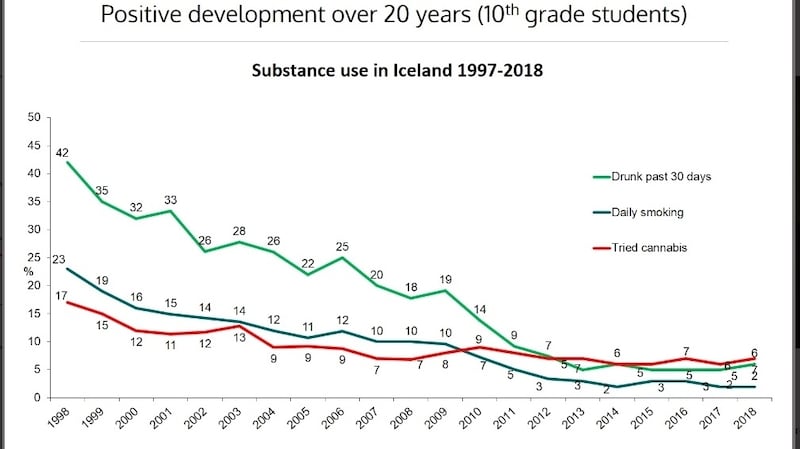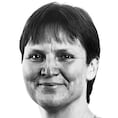Iceland used to be top of the league that no country wants to win – scoring exceptionally highly on the teenage use of alcohol, tobacco and other drugs.
Among young people aged 15/16 years, almost 25 per cent were smoking every day, more than 40 per cent had got drunk in the past month and 17 per cent had tried cannabis. That statistical snapshot indicates the depth of the problem the Nordic island had with substance abuse by teenagers 20 years ago.
In 2017, just 2 per cent of that same age group were daily smokers, 5 per cent reported having been drunk in the previous month and 6 per cent had tried cannabis. By any measure, that is a spectacular turnaround.
So how did they do it and would that work in Ireland?
This is what the Western Region Drug and Alcohol Task Force has been looking at.
With the support of partners such as the HSE, Tusla and local schools, the task force has embarked on an ambitious five-year pilot project to customise and implement Iceland’s “Planet Youth” model in the counties of Galway, Mayo and Roscommon. Its aim is to improve the health and happiness of all young people, which would be both cause and effect of them turning away from substance abuse.
Radical action
But as you might expect, the radical change in trends that was achieved in Iceland requires radical action – quite different from the typically piecemeal approach in Ireland of education programmes here and there. Planet Youth is all about prevention through a "whole-population" approach.

Here are some of the steps Iceland took, within its population of 360,000, to divert teenagers away from drink and drugs and embrace a healthier lifestyle.
1. First they surveyed all 13-16-year-olds, to try to drill down into the differences in the lives of those who were using drink and drugs and those who were not. The findings informed their action plan. Extensive youth surveys continue to be conducted every year, with results reported back within two months to individual schools and communities to help them to identify and tackle particular challenges in their areas.
2. Laws were changed to make it illegal to buy tobacco under the age of 18 and alcohol under the age of 20. Advertising of both tobacco and alcohol was banned.
3. A curfew was introduced for all children under 17. The "outdoors hours limit" stipulated that under 12s should be indoors by 8pm and ages 13-16 by 10pm. (For the summer that was extended to 10pm and midnight respectively.)
4. Groups of parents were encouraged to draw up and sign pledges on things such as not giving alcohol to those underage, limiting screen time, organising dedicated family time, etc.
5. In a new focus on keeping children occupied, a "leisure card", now worth €430 a year for each child, was given to parents to help fund out-of-school activities.
6. Scientific evidence was used to secure political backing through policies and funding. Reykjavik now spends about 7 per cent of the city budget on youth activities. (Here, the National Youth Council of Ireland has been protesting that the €60.4 million investment in youth work services by the Department of Children and Youth Affairs this year was 17 per cent below 2008 levels.)
‘Unbelievable results’
"Iceland has had unbelievable results. They did a right serious number on it," says Emmet Major, a community liaison officer with the task force. He is co-ordinating the attempt to do something similar in the western region, within a population of about 453,000 – of which just over 117,000 are aged under 18. The Icelandic Centre for Social Research and Analysis in Reykjavik University, which developed the Planet Youth model, is involved with the Irish pilot.
The first step was to survey almost 4,500 15/16-year-olds in every single one of the 82 secondary schools, and also in Youthreach centres, across the three counties. An in-depth questionnaire, comprising 77 questions, gathered data about their habits, health, relationships with family and peers, attitudes to school etc.
The data was processed at Reykjavik University, with some of the main findings published last May. Individual schools also got the anonymised results from their pupil group, enabling them to identify if they were out of step, for better or for worse, with the norms of the region.
Risk factors and protective factors for teenage substance use are well established. By capturing the nitty-gritty reality of teenage lives, the opportunities for trying to reduce the risks and strengthen the positives become more apparent.
While the positive findings of the western survey include most having good relationships with parents, a broad societal tolerance towards underage drinking is apparent, which, the Planet Youth report concludes, “permeates into adolescent decision-making and norms and needs to be challenged”.
The model is relatively straightforward: conduct a comprehensive survey to establish what you’re dealing with in a community; respond to the findings with interventions to make changes; do another survey to gauge the impact of those actions . . . and repeat.
The information that has been gathered from the 15- and 16-year-olds in the west will be used to change the situation for the ones coming behind them, explains Major. “Those kids are gone. We can do nothing to change the trajectory they’re on, other than what we currently do, which is firefight” – essentially work with the ones already sucked into substance abuse and getting into trouble.

However, for today’s first-year students in the western region, it could be a different story. Since September, representatives have been visiting schools to give presentations to parents of first-year pupils on what the data is saying about students just three years ahead of their children. The more worrying statistics include: 46 per cent having been drunk on at least one occasion, 26 per cent having been drunk in the last month and 23 per cent reporting that their mental health is bad or very bad.
“We are telling them those are the numbers we want to change for your kids. If we don’t do something differently, there is no reason in the world that they will have different outcomes from the current age group,” Major points out.
What parents can do
Then come the ideas about what parents can do. By working together they can, for a start, squash the age-old “but everybody else is allowed . . .” argument the instant it starts to come out of a protesting teenager’s mouth.
The data shows that bedtimes and screen times are “way off”, says Major, which undoubtedly affects mental health. A simple rule of “no screens in the bedroom, ever”, would greatly help, he points out.
Parents are advised that if they enforce that rule in the first term of first year, they have a chance to keep it going. And that “if you work together, back each other and everybody does roughly the same thing, your life will be so much easier”.
It is a fantastic initiative. It is giving parents the skills on how to parent a teenager in the modern, technology world
Starting secondary school is a huge transition in a child’s life. The same could be said for the parents, who move from, typically, having spent eight years with the same small group at the school gate, to knowing few if any at secondary level.
They’re encouraged to get involved with school activities and to network with other parents so, as Major explains, when your child says she wants to stay with Mary tonight, you know who Mary is and who her parents are. That is a “massive protective factor” in keeping teenagers from going off the rails.
The Parents' Council at Presentation College in Athenry, Co Galway, was unanimous in welcoming Planet Youth to the school, which has more than 1,100 students. Some 80 per cent of parents of the 180 first-year pupils took up the invitation to attend an information evening. The college has 25 feeder schools so many new parents would know few others initially.
"It is a fantastic initiative," says parents' council chairwoman Doreen Geoghegan. "It is giving parents the skills on how to parent a teenager in the modern, technology world. Everything has gone into cyberland and it is very hard to parent in there."
While some of the statistics were quite worrying for parents, she says, they were encouraged to believe they could instil good habits in children and that, despite the power of peers, parents continue to be a crucial influence in teenagers’ lives.
Geoghegan, who is the mother of three children aged 11, 14 and 16, believes the agreeing of rules within the parent group and the support of each other is very important.
“These are very simple rules but they are very, very effective. There is no muddying of the waters.”
Second year is the worst year, she continues, so it is very important parents get in there “before the friends become the most important persons in their [teenagers’] life for a time”.
She describes the Planet Youth evening as “one of the most exciting events we have run for parents”. The research, she adds, totally supports the “why” of the advice they were being given.
Deirdre Neary, whose daughter is in first year, is one of the parents who attended. The reinforcing of the need to limit screen time was one of the elements that most resonated with her and she also sees huge value in the idea of the parental community.
“We have become so isolated, running in our own tracks without keeping an eye out for each other. From that perspective, I thought it was very powerful.”
She also feels she is more aware of the pitfalls that could lie ahead. “I could start the conversation more easily now with another parent. It gave me language in and around that.”
It has already had an effect in connecting the parents, she adds. “We interact more at the edge of the community” – whether that’s while standing on the side of a sports pitch or at some other activity.
Renata Gaiderova, whose eldest son is in first year at the college, says it is a "brilliant" initiative. Of parenting a teenager, she says: "You have to be worried all the time."
‘Positive vibes’
If parents stick together on this, she adds, “we are going to bring the positive vibes to our young adults”.
Through the first-year parents' evenings, the task force has collected contact details that they will use to keep parents informed about relevant events. In November, they brought in Colman Noctor of St Patrick's Mental Health Services to talk on "Raising Resilient Children in the Digital Age" and the three evenings, one in each of the three counties, were booked out.

Internationally, Planet Youth now operates within 110 communities in 31 countries and Major says at first the task force was curious to see how Irish adolescents were stacking up internationally. Then they realised, "it really doesn't matter how we compare to Russia or Chile, what really matters is how we are".
An overall reduction in the level of drinking among young people in Ireland has been indicated in various surveys, including Jigsaw’s My World Survey 2 (MWS-2) that was published in November. However, although fewer adolescents reported drinking than in the MWS-1 in 2012, those who did engaged in more problematic drinking than adolescents seven years earlier.
“I am in the job 10 years and I am not seeing that reduction, I am just not,” says Major. And he has no doubt that the figures for cannabis use are going up all the time. “That ship has sailed now – the kids think dope is great and it is very available to them.”
While Reykjavik University has processed the data for the task force – and will do so again for follow-up surveys in 2020 and 2022 – it doesn’t prescribe what actions communities should take.
“How do you get it to work in your local context is the hard part,” says Major. “We have to change the way we do stuff and think about stuff – not that easy in Ireland.”
The steering committees in the three counties are preparing a document that is due to be launched at the end of January 2020, with proposals that include increased provision of after-school and holiday-time structured activities for teenagers, and more accessible parenting support for all. "It will be a road map for the four years ahead," says Major, who hopes the western task force will be the pathfinders for the rest of Ireland. Already, there are plans to kick it off in the Fingal area of north Dublin with a survey of adolescents in autumn 2020. (For more advice on how to communicate with your child about alcohol and drugs, see the HSE's Parent's Guide at AskAboutAlcohol.ie)
The good, the bad and the ugly
Here is a snapshot of some of the findings made after surveying students aged 15-16 in Galway, Mayo and Roscommon:
91% say it's easy to get care and warmth from parents
89% feel happy in their community
82% are happy in their lives
53% exercise three times a week or more
23% report mental health bad or very bad
30% tried alcohol by age 13
46% have been drunk on at least one occasion
26% have been drunk in the last month
18% have tried cannabis
Guidelines for parents
Screen time: a maximum of two hours a day is recommended. The survey showed nearly half the teenagers spent three hours or more daily on screens. Devices should be put off one hour before bedtime and kept out of bedrooms at night.
Bedtimes: with the survey showing teenagers are not getting enough sleep, the task force has produced fridge magnets for all to see with recommended bedtimes starting at 9.30pm for first-year students and increasing by 15 minutes every year to 10.45pm in sixth year.
Sport and hobbies: encourage young people as they get older to stay engaged with structured and supervised activities. As well as being good for physical health, emotional resilience and building social skills, they are a known protective factor against substance use and anti-social behaviour.
Alcohol: the best thing we can do as parents is to try to defer alcohol use by our children for as long as possible. With a third of the teenagers saying they are doing their drinking in a friend's house, parents should agree not to give any alcohol to other children in their homes.
Vaping: e-cigarettes are unsafe for adolescents, yet 14 per cent report using them in the past month. Ideally, parents should remain nicotine-free themselves and talk to their children about the dangers of vaping.
Family time: the warmth of family is one of the most positive aspects reported by the teenagers. Having shared interests and regular family meals and activities help to create the time for the open communication that is so vital during teenage years. It's also important we set good examples with our own behaviour.



















